MPP - MICROPRESS
- PRESTIGE
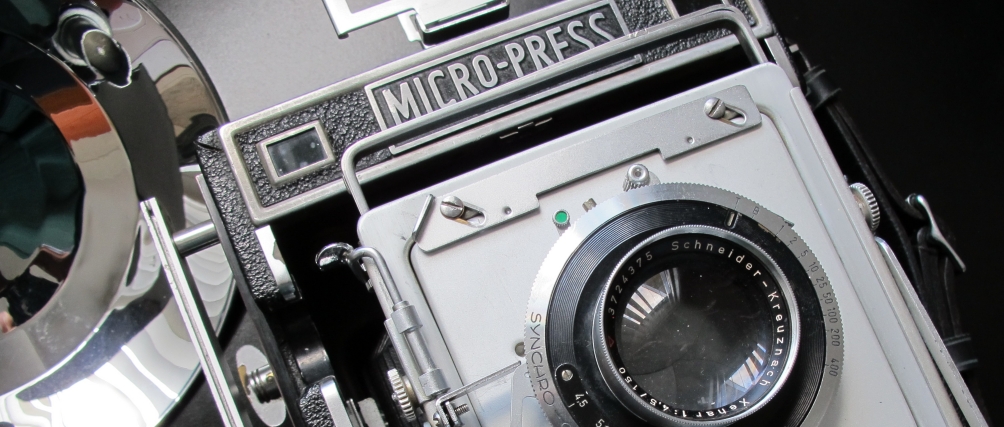
"Micro prestige"
Micro refers
to the company which produced fine mechanics and certainly not to the shape of
this huge press camera.
"Micro Prestige" is the headline of an article in the Amateur Photographer edition September 1956
and the article continued with
"few 5x4 cameras are held in higher regard by professional users than the
Micro-Press."
And yes, its huge impressing performance and beautiful design combined with lots
of essential features makes it a
dream for the real press photographer. I herewith present a nearer look at this
British competitor of the
US Graflex.
As said before the MPP Micropress is far from micro as its name might suggest.
In the contrary, it is a huge 4x5 format film camera with on top a huge build in
rangefinder. You'll see immediately some family traits pointing in the direction
of the US Graflex family and yes 80 percent of its design comes from the
Pacemaker Speed Graphic which needs no further introduction. There are however
some interesting details which never the less are very important. The drop bed
has another construction as well as the bed brackets. The rangefinder is of a
completely new design. Further more the lens standard slider and the track yoke
differs from the Speed Graphic which makes that both are not interchangeable
with the Graflex parts. The focal plane shutter seems to be the same, but closer
examination learns that there are huge differences.
The honourable
M.P.P. Micro-press
Made in Britain from 1950-1966 using American parts and Graflex
design.
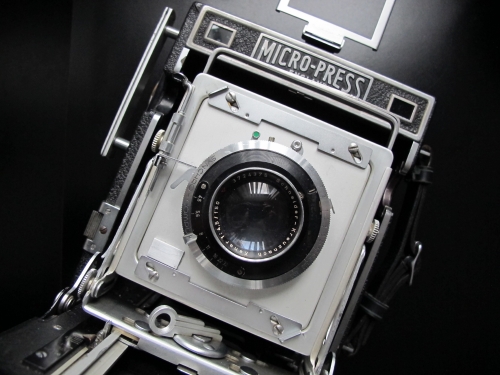
By Jo Lommen
The Micro Precision
Products Ltd.
- 146 London Road Kingston
upon Thames Telephone Kingston 0153 -
The M.P.P 5x4 Micropress
Camera # 4084 year of production 1950
Real British press camera with American roots
.
Takes roll films, American
Grafmatic magazines and adaptor for 9x12 metal slides.
The M.P.P. Micro-press is designed and build to the ideals of leading
professional photographers. It gives a bit of performance of a studio camera
with the compactness, portability and simplicity of a press camera. It has the
utmost flexibility and will cope with difficult photographic problems whatever
their nature.
The Micro-press Camera has a
mahogany housing, leather bellows, drop baseboard to 30 degrees,
wide angle rack, dual extension, rising, tilting, cross and swing front, quick
release lens-panel, direct vision view finder, four way swing rotational
universal back with spring loaded slide holder and a slide lock to fix the
focusing rack. A single body release with slide selector for both focal plane
shutter and front shutters. Removable focusing
screen-hood. Cable release holder. Flash-gun bracket. Accessory shoe for sports
finder. Rangefinder instantly coupled to lenses by interchangeable cams. A
choice of accessories under which negative holders 2 1/4 x 3 1/4 or roll film
holders 4 1/2 x 3 1/4 inch. plates, sheet film and cut film is Grafmatic holder.
Weight 3250 gram. Dimensions 8x8x4 in.
Camera £ 85 Lens
extra.
In 1956 camera with 135 f/4,7 Xenar in Compur shutter with blade arrestor
cost £ 110,0.0
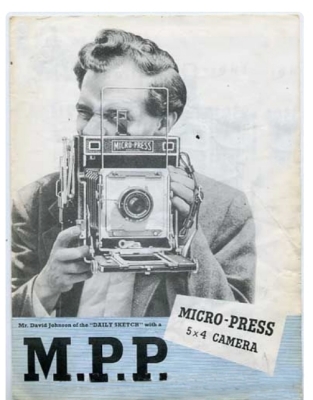
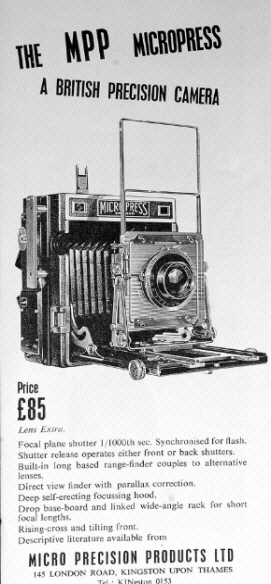
David Johnson of the Daily Sketch in a M.P.P. Advertisement.
The M.P.P. Precision retail price 85 Pound Sterling in the fifties.
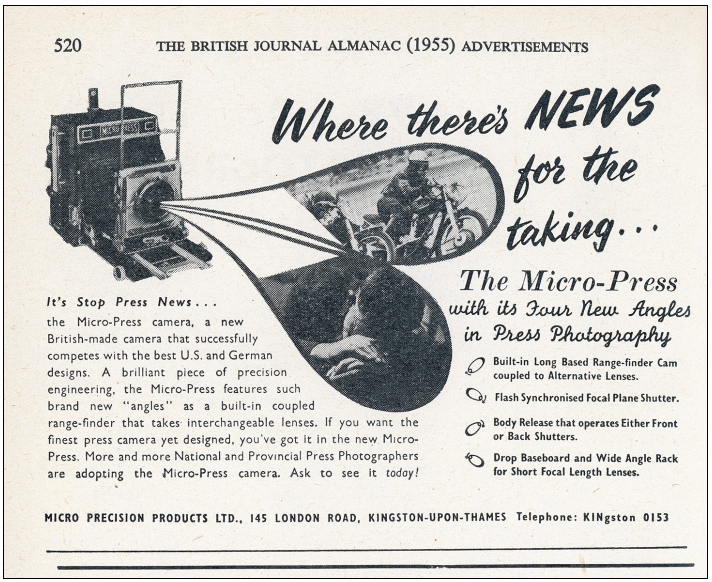
At the first glance the M.P.P is a look alike of
the Pacemaker Speed Graphic. However there are some details that asks for a
nearer look. The first striking difference is the integrated rangefinder. Unlike
the Pacemaker Graflex top mounted rangefinder, the M.P.P. Micropress rangefinder
is an integral part of the camera body and gives the camera the unique and
striking design, undoubtedly the touch-of-the-fifties. The weight is at least as
touching as the design and the camera-man should have the strength of a boxer to
carry the huge camera with a weight of more than 5 kg which includes the flash
plus the 6 sheet Grafmatic holder. Carrying is one thing but holding the camera
in front of your face when focusing is another thing.
The open frame-finder should not be relied
upon to give the exact coverage of a subject, as the area seen through the
viewfinder will vary considerably from person to person and is greatly affected
if the operator is wearing spectacles. By the way, focussing can only be done
using the standard frame finder. Both windows on top of the camera
suggesting being an optical viewfinder or at least a part of it, are serving as
a rangefinder. The integrated rangefinder is coupled to the track with the lens
standard. Interchangeable cams make it possible to change lenses.
Having said that it is
about time to mention the positive side of this camera. Reason to take the M.P.P
Micro-Press in the hand and to open it and take a closer look. The
first thing we'll see are the brackets holding the drop bed. These are very nice
made and much better than the Graflex brackets. The eye catching top rangefinder
asks for attention. Comparing the to the top mounted Graflex viewfinder it is a relative easy
design and construction. The optical image and contrast as well as the working
of the mechanical coupling to the focusing rail are
perfect. At the first glance all other components look the
same as the Pacemaker Graflex camera. The lens-standard including its
frame-finder and lensboard-lock-sliders, the yoke between the drop bed guides,
the infinity stops, the build in release knob, the front shutter release
mechanic with its Bowden cable and last but not least, the bellows.
Non interchangeable parts!
In fact I'm sure originally these are
fundamentally the same components, but they won't fit, they are not
interchangeable with the Graflex camera! The lens standard does match the Graflex yoke, the yoke
doesn't fit to the Graflex drop bed guides and the shutter release mechanic
won't match the lens standard. The Graflex guide blocs would not fit to the
Micropress drop bed and the Graflex drop bed not to the Micropress camera.
Perhaps nice to know which Graflex part does match the Micropress. Well
that would be the build in release knob and the knurled wheels of the lens
standard. I'm pretty sure they used 80 percent of all the original Graflex parts
but made minor modifications. For what reason? It might have something to do
with the UK post war financial situation, or to prevent re-import from UK to
USA, or the bad economic situation in UK in those years. It would be nice
to find out the real reason about all this.
In the appendix
you'll find the interchangeable and non-interchangeable parts
with the Graflex camera.
It's about time to get an idea of the inner of the Micropress
camera and we'll start right on the front with the rangefinder. Integrated in
the camera body, the prism and beam splitter located behind both windows are
connected by a fine mechanic steering mechanism to the plunger next the
exchangeable cam in the back rack. Turning the focusing knobs make the beam
splitter rotate around its axle and projects the image on the prism. The
photographer's eye
will see two images drifting together and coinside to one single image as soon
as the real distance to the subject has been focused. None of these optic components matches with any
Kalart or Graflex parts. Note the simple but efficient construction using a
tooth gear to couple the moveable cam with the right mirror. The left
mirror is a so called beam splitter. The left "port" receives the image of the
right mirror as well as the image strait forward and reflects half of the mirror
image while the other half stays transparent.
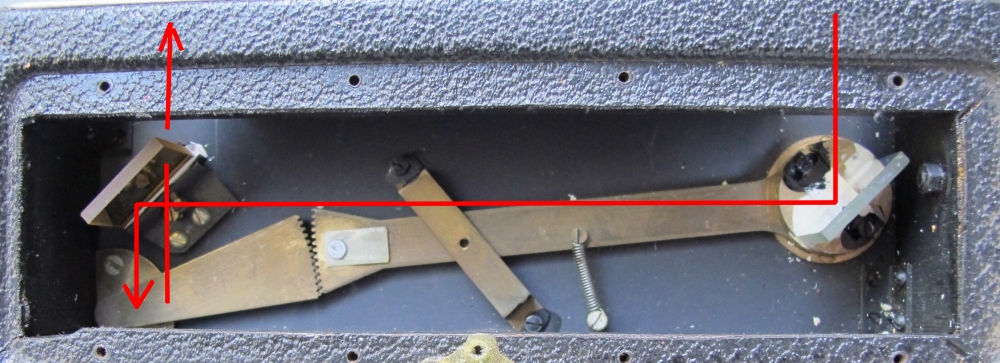
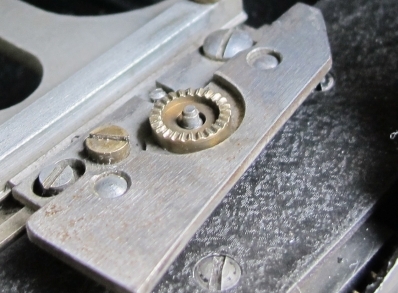
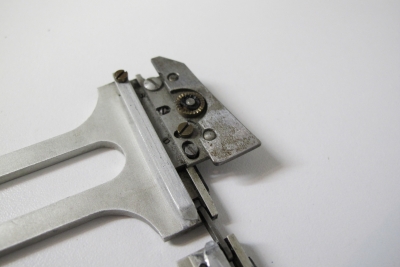
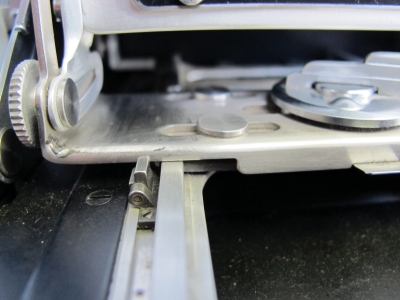
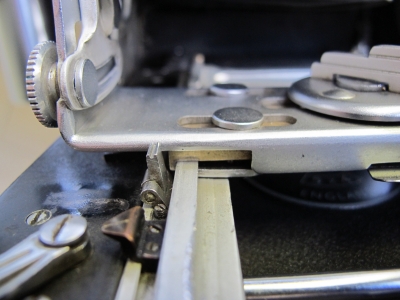
The movement of the Rangefinder is actuated by a cam which is
located on the focusing track back rack. The cam is fitted with dowel holes and is secured with
only one screw so that it is readily detachable. The cams are engraved with the
serial number of the lens with which they are associated. By these easily
interchangeable cams the rangefinder may be coupled to an infinite number of
lenses. This cam actuates a gear which is connected by a shaft that makes the
mirror rotating when focussing.
Minor differences between both cameras such as the infinity stops and the higher
positioned lens standard brackets (photos 3 and 4 ) make it impossible to
exchange parts from Graflex to M.P.P. or the other way around.
Next secret to be solved would be the shutter mechanism. The
Focal Plane shutter is expected to be the same as the Graflex shutter as it has
the same 4 slits which are visible from the outside when the ground glass back
has been removed. Winding the shutter is the same procedure as winding the
Graflex and the setting for front and rear shutter is also the same as Graflex.
The M.P.P shutter selector slide works exact the same as the Graflex but inside
you'll find different parts. The release mechanics are the same as the Graflex
parts, but they can't be interchanged due to minor differences. Finally the
wooden dark box. Almost every part seems to be interchangeable. I must admit I
didn't check that up till now.
Now we reach the elementary part of the rear shutter. The
focal plane shutter has two rollers. The one in the upper compartment has a
build in mechanic safety break to prevent winding the curtain further than its
length and thus the risk of tearing it off from the roller. The roller has a
square shaft end fitting into the bushing with a square hole. Inside the roller
there is a shaft with a thread and bolt. Winding the key the roller thread moves
the bolt to the end of a 2 inch long gap. Once the bolt reaches the end of the
gap, the curtain will be on the end of its travel along the film back. Hence the
winding can not be proceeded the fabric can not be torn off the roller. Great
invention!
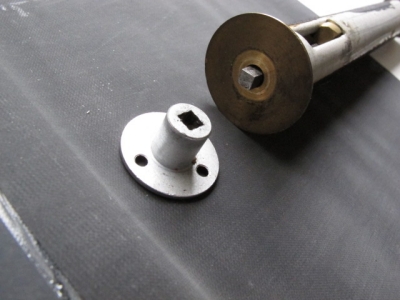
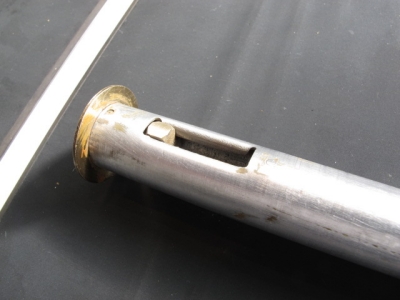
The track and front standard look very much like the Graflex
Pacemaker Crown or Speed camera. Most of the M.P.P components are almost the same as used in the Speed
Graphic although not too many of them can be mutually exchanged. The lens
standard is almost 100 percent the same but has a different slider which is a bit thicker than
the one of the Graflex and thus wont fit on the track. Upper and lower roller
are different and not interchangeable. Track, back with ground glass, bed-brackets,
drop base board, housing including build in rangefinder. All
together it is easier to list the compatible parts such as the bellows, the build
in release knob and its build in mechanism, the release arm and lens board.
Tilt, slide and rising front nuts are exactly the same as the Graflex ones. The
camera back is equiped with a focusing panel which accepts film holders with the
raised lock rib trap. The springs are a bit different, but the working of the
back is exactly the same. The spring loaded focusing panel frame pulls back to
accept the Graphic type 5, Rightway, Lisco Regal II and other compatible 4x5
holders as well as the Graphic Grafmatic film holder. A closer inspection of the
camera shows the winding mechanism on the right side of the camera. The position
and the working of the winding key, the slide shutter selector, flash bi-post,
shutter speed control, the shutter speed window and lever at the bottom of the
plate cover are exactly like the Pacemaker Speed Graphic camera. However the
winding key itself is not interchangeable with the Graflex camera. Also the
mechanics inside have minor divergences and are not interchangeable.
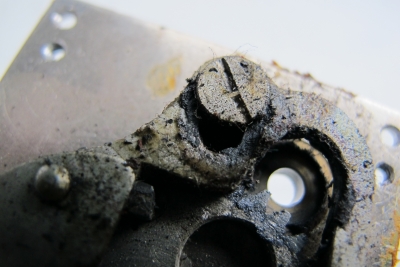
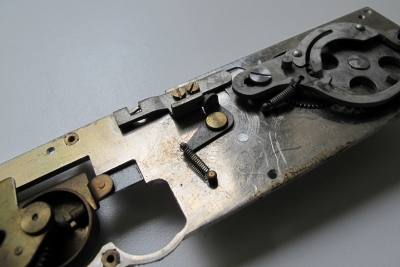
Cleaning is essential for the good working.
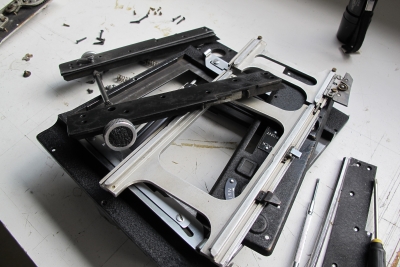
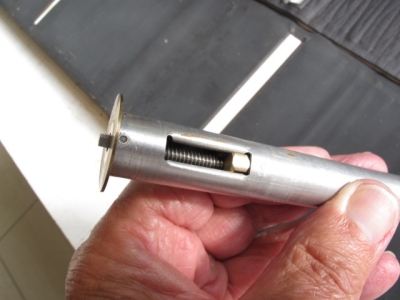
Photos © Jo Lommen.
After a long period of time
and depending on bad storage conditions, the mechanic parts inside
should be cleaned thoroughly from dirt and old grease to prevent malfunction and slow shutter speeds.
Focusing bed, track, guides and yoke need some care after half a century, while
the curtain should be checked for light-leaks and rollers including the inside
springs should be cleaned to new
condition before renewing or replacing the curtain.
Without this maintenance the camera would be not reliable and thus worthless for photographing.
Also lens
and front shutter need attention and adjusting.
For more details about compatible and non compatible parts see:
Compatible and non
compatible Graflex parts
To find out all about the working read the:
M.P.P. Micropress Manual
Home
Jo Lommen Camera
Back
to European cameras















